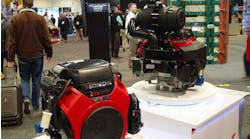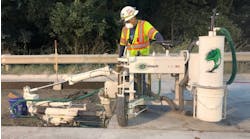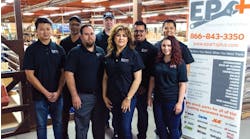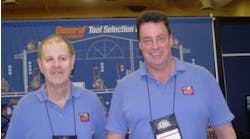Case showed it’s still in the big leagues with an ambitious presentation at World of Concrete.
Case Construction Equipment hit the 2008 trade show running at the World of Concrete with 17 new machines and equipment redesigns including skid-steer loaders, telehandlers, compact track loaders, backhoe loaders and a wheel loader.
Starting with the heavy, the 521E model wheel loaders, an addition to Case’s E Series line of wheel loaders, features an electronically controlled engine with increased horsepower, a more comfortable cab with a payload capacity of 2.5 cubic yards. The Tier-III certified engine incorporates a common-rail fuel-injection system, which allows highly pressurized fuel to mix efficiently for cleaner combustion and increased fuel economy.
In the wheel loader, as in all new Case machines, the cabs are more roomy and comfortable with more thorough heating and cooling. Floor-to-ceiling glass in the front, with a sloping rear engine compartment, visibility is enhanced.
“The operator has a clear, direct view to the front tires, the bucket edge and the work site,” said Case brand marketing manager Dave Wolf.
The unit features a standard single-level joystick loader control with forward-neutral-reverse quick shuttle switch with a transmission downshift button to facilitate operator control.
Case introduced three telescopic handlers. The TX742 (6,600 pounds, 42-foot reach), TX842 (8,000 pounds, 42-foot reach) and TX945 (9,000 pounds, 45-foot reach) are designed for enhanced visibility, with four forward and three reverse gears. The 153-inch turning radius is designed for maneuverability in confined spaces.
The TX742 is rated at 95 net horsepower, while the TX842 and TX945 are rated at 108 net horsepower. “All three machines can reach a top speed of 22 mph in forward and 14 mph in reverse for quick maneuvering across the jobsite,” said brand marketing manager Jim Hughes.
Front and rear work lights and mirrors are standard. The machines feature three available steering modes. “Front-wheel steer provides maximum control at high transport speeds,” added Hughes. “Four-wheel steer provides maximum maneuverability and a tight turning radius; and crab steer provides maneuverability when stacking pallets or working beside a structure.”
Case did a lot of research to see what its customers were looking for, what they liked about current machines and what they didn’t like.
“There are three main drivers,” said Hughes. Cab comfort, productivity, serviceability. The machine offers outstanding visibility for the forks whether they are in the fully extended and down position, or fully raised position. We’ve got ample legroom and space inside the cab. We talked with a lot of customers during our test phase and they really comment how spacious that cab is.”
In addition to more spacious cabin, many of Case’s new machines feature conveniences such as outlets for cell phones, radios and MP3 players.
Case also presented its new 400 Series 3 line of skid-steer loaders, which also emphasize more powerful engines, redesigned cabs and more efficient serviceability. Tier-II certified engines are available on the 410, 420, 430,435,440, 445, 450 and 465 skid-steer loaders, which range from 57 to 83 net horsepower. The 420, 430, 435 and 445 Series 3 machines have Case 3.2-liter turbocharged engines.
The units are designed to excel in cold weather, with the 410 Series tested to start unaided at 0 degrees F, while the rest are designed to start unaided at –10.
Case also introduced the new M Series 3 line of loader/backhoes. The Super M and Super M+ units feature pressure compensated load-sensing hydraulics to improve fuel efficiency, helping move more yards per gallon of fuel. The M Series 3 units are available with one-touch idle built into the Case Pilot controls, allowing the operator to return the engine to idle at the touch of the button.





